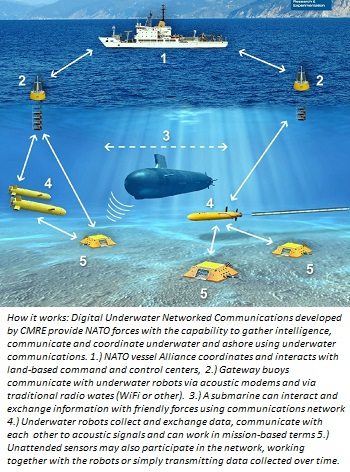Satellites and mobile phones, built on international standards, help the world get connected. But the communications technology we use on land does not work well underwater. As water covers over 70 percent of the earth’s surface, NATO has sponsored research into establishing the first ever digital underwater communications standard, according to the NATO report.
Imagine a scuba diver approaching the surface, being made aware of nearby boating activity; or a submarine communicating with a land-based command post; or an underwater robot sending a warning to an oil rig after a leak is detected – the possible applications of underwater communications are limitless.
It could be used in many areas: for harbour protection, maritime surveillance, mine detection, surveying offshore wind farms and pipelines, or even underwater archaeology.
The NATO Science and Technology Organization’s Centre for Maritime Research and Experimentation (CMRE) has developed a standard for underwater acoustic communications called JANUS, which is recognized as a NATO standard by all NATO Allies since March 24, 2017. This marks the first time a digital underwater communication protocol has been acknowledged at international level and opens the way to develop many exciting underwater communication applications, according to NATO.
CMRE is working to support effective underwater communication networks to allow undersea robots to work together and report back home.
With effective undersea communication, this can all happen in an autonomous way, without requiring direct human intervention. If needed, the operation can be managed by land-based engineers who monitor all the communications from a command and control room ashore. The connection to land is made through gateway buoys on the water’s surface equipped with radio links to local support platforms or satellites.
To be able to communicate with each other, underwater assets need common standards. “In the air we can simply connect our gadgets to any WiFi hotspot without having to worry about the compatibility,” says João Alves. “Until now, there wasn’t anything even remotely similar for the underwater domain.”
As with the industry standard for WiFi communication, an undersea communication standard has to be defined in order to guarantee the interoperability between equipment from different manufacturers. For the past ten years, CMRE has been working on the development of the first international digital underwater communication protocol, known as JANUS, which is now an approved NATO standard.
Adopted globally, JANUS can make military and civilian, NATO and non-NATO devices interoperable, providing them all with a common language with which to communicate and arrange to cooperate.
May 31, 2017





Reader Interactions